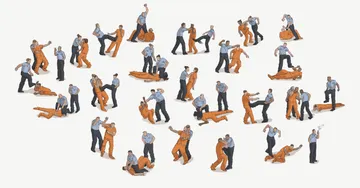Of the hundreds of photos from Charlottesville, Va., that circulated online this weekend, a few seemed destined to be cited as evidence of crimes. One photo shows three men beating 20 year-old Deandre Harris with poles in a parking garage. “I have eight staples in my head, a broken wrist, and a chipped tooth,” Harris told The Root. One attacker wore a white construction helmet, another sported a long red beard. Who were they?
Internet sleuths got to work, and by Monday morning they were naming names and calling for arrests.
The name of the helmeted man went viral after New York Daily News columnist Shaun King posted a series of photos on Twitter and Facebook that more clearly showed his face and connected him to photos from a Facebook account. “Neck moles gave it away,” King wrote in his posts, which were shared more than 77,000 times. But the name of the red-bearded assailant was less clear: some on Twitter claimed it was a Texas man who goes by a Nordic alias online. Others were sure it was a Michigan man who, according to Facebook, attended high school with other white nationalist demonstrators depicted in photos from Charlottesville.
After being contacted for comment by The Marshall Project, the Michigan man removed his Facebook page from public view.
Such speculation, especially when it is not conclusive, has created new challenges for law enforcement. There is the obvious risk of false identification. In 2013, internet users wrongly identified university student Sunil Tripathi as a suspect in the Boston marathon bombing, prompting the internet forum Reddit to issue an apology for fostering “online witch hunts.” Already, an Arkansas professor was misidentified as as a torch-bearing protester, though not a criminal suspect, at the Charlottesville rallies.
Beyond the cost to misidentified suspects, the crowdsourced identification of criminal suspects is both a benefit and burden to investigators.
“If someone says: ‘hey, I have a picture of someone assaulting another person, and committing a hate crime,' that's great,” said Sgt. Sean Whitcomb, the spokesman for the Seattle Police Department, which used social media to help identify the pilot of a drone that crashed into a 2015 Pride Parade. (The man was convicted in January.) “But saying, 'I am pretty sure that this person is so and so’. Well, ‘pretty sure’ is not going to cut it.”
Still, credible information can help police establish probable cause, which means they can ask a judge to sign off on either a search warrant, an arrest warrant, or both.
“You have to take more time when social media is involved just to make sure that it's the right person who you are charging, and it's not just the perception of the individual who was victimized, who just wants to ID somebody to give closure to themselves,” said Lt. John Walker, who supervises 31 detectives in the Philadelphia Police Department’s West Philadelphia office. “You have to do the right thing.”
Walker says his team has had at least seven cases since January in which officials were able to identify a potential suspect because of civilians sleuthing on Instagram, Facebook or Twitter. Just last week, the local FOX affiliate shared a viral Facebook video with detectives. The footage featured a group of young women pummeling a 26-year-old female on a city street. After the video aired, Walker says, “the father of the victim searched through the community, and was able to get a name for us. We showed a photo array to the victim, and she was able to identify the person.”
A successful arrest assisted by mass interest on social media doesn’t necessarily lead to a successful conviction. Prosecutors dropped the charges against a shooting suspect, Walker recalled, after his attorney argued that the identification process “was tainted” because the victim had seen the suspect’s name and photos on Facebook. It’s becoming more common, at least in Philadelphia, for defense attorneys to petition the court to order additional line-ups after police finger a suspect with the help of social media.
“If the victim really doesn't know” who did it, “and is tuned into social media, and sees a frenzy of people ID’ing someone, they will latch on to it,” said Philadelphia-area defense lawyer Michael Fienman. “So many people say, ‘it must be him’. They adopt that view." Dozens of wrongful convictions have featured mistaken identifications.
Prosecutors and police in Charlottesville could not be reached for comment, and so it remains unknown whether any of the men named online have been questioned or arrested. Lt. Scott Doughman of the Mason, Ohio, Police Department said he had received numerous calls about the white-helmeted assailant, who reportedly hails from the city but moved away after high school.
The internet sleuths continued their work on Monday. One Twitter user, who had publicly offered a name of the red-bearded attacker, declined to give his own name when contacted by a reporter. “I don’t want my name in print, and have these violent guys show up at my door,” he wrote in a Twitter message to The Marshall Project. He felt “very torn” about sharing names publicly. “I hesitated to post,” he wrote, but “the emotion of what these people did really got to me.”
Correction: An earlier version of this story misstated when a Seattle man identified through social media was convicted of crashing a drone into a parade. He was convicted in January.
